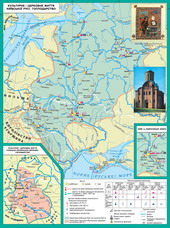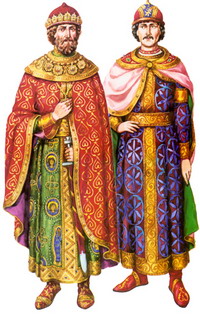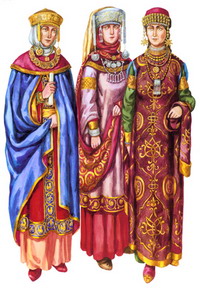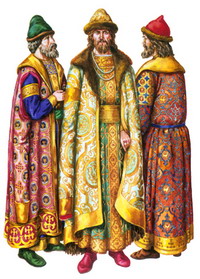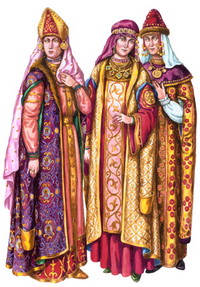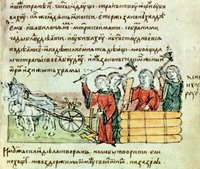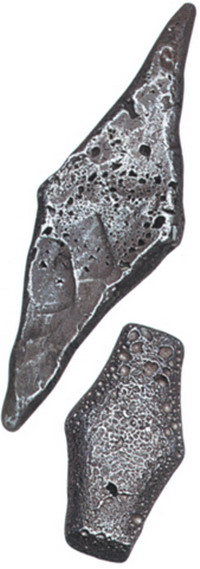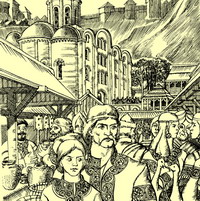Political, social order and economic life of Kievan Rus and Galicia-Volyn state
Plan presentation
- political divisions of Kievan Rus and Galicia-Volyn principality.
- social structure of Kievan Rus and Galicia-Volyn principality.
- forms of tenure.
- feudal duties.
- economic life.
main presentation
1. Political divisions of Kievan Rus and Galicia-Volyn state
Duke Power
-
 The greatest power in Kievan Rus, and Galicia-Volyn state were princes.
The greatest power in Kievan Rus, and Galicia-Volyn state were princes.
- Princes care of law and justice, led the army, has taken a decision to defend the country, taking a direct part in military expeditions.
- They forged relations with neighboring countries, concluded peace or declared war.
- Thus, using modern terminology, we say that the prince of Rus was head of state lands, it embodied a quiet, ordinary life of society.
- princely power passed from father to son, that she was hereditary .
- Of all the princes of Kyiv prince had the greatest power, the rest of the princes obeyed him as the oldest, most high. Such relations are called mizhknyazivski vasalitetom , and form of government - monarchy .
Political divisions of Kievan Rus and Galicia-Volyn principality researchers define as a federal- monarch .
Council of Prince
-
 In addition to the princes, the state power in the Ruthenian lands carried Council of the prince, Prince conventions, rallies.
In addition to the princes, the state power in the Ruthenian lands carried Council of the prince, Prince conventions, rallies.
- for strong role of the prince's power was formal and, consequently, when the princely power was weaker, the council won more weight.
- Thus, the important role played boyar council the Galician Principality.
- However, no matter how influential were the boyar council, they would prefer to have a let and obedient, but still the prince.
Conventions princes
grave authority had princely congresses. They gathered regularly and not all solutions such gatherings have been realized, but the questions they discussed at the congresses were mostly of national importance.
- particularly sensitive issue that was discussed at the princely congresses, was the protection of Polovtsian. Here princes showed determination and unanimity.
Vecha
- rallies, gathered more ancient Slavs. Ancient slavic rallies - a meeting of the whole community to address critical issues of life.
- Vecha same Kievan Rus' and Galicia-Volyn state charges were powerful - powerful boyars, men, wealthy merchants, and this difference from the old face.
2. Social divisions of Kievan Rus and Galicia-Volyn state
At the top of the social pyramid Ruthenian society were princes.
- princes occupied the greatest power in the state.
- prince in the Ruthenian lands could only be representative of the Rurik dynasty family.
- head of state and influential Duke was Grand Prince of Kyiv.
- capitals land-autonomous principalities sat princes. Each principality, in turn, divided into small parish, which also ruled by princes.
- only son of Prince could be a prince.
addition princes belonged to the ruling class boyars.
-

 Boyarskaya formed with the families of local notables rodopleminnoyi and with influential men, who by military service received from the estates of the princes of the land.
Boyarskaya formed with the families of local notables rodopleminnoyi and with influential men, who by military service received from the estates of the princes of the land.
- boyars together with the princes were ruling the state, the Principality.
- Big boyars became rulers, rulers of thousands, but small - sotskymy, tens, tiunamy (bailiff), butler, etc..
privileged social group was Ruthenian society arms - professional soldiers.
- They were not only in military campaigns, but also covered some government positions.
- for faithful service to Prince warriors were given cash incentives, and land.
states belong to the privileged and clergy.
- clergy were the most educated stratum of contemporary society.
- Clergy divided into top (metropolitan bishops, Superior of the monastery) and the ordinary priests.
- prominently played in the life of the monks of monasteries.
the middle of social pyramid sat wealthy urban elite, as well as merchants and artisans.
At lower levels of the social pyramid were Ruthenian society: smerds, people, shopping, ryadovychi, servants, laborers, SLAVES, rogue .
-
 The most numerous group of the then population - peasant-smerds . They were personally free, have their own farm land, lived in villages and princely prince paid tribute.
The most numerous group of the then population - peasant-smerds . They were personally free, have their own farm land, lived in villages and princely prince paid tribute.
- Peasants in written sources also called simply « people » - mostly residents of rural communities.
- smerds If, for some circumstances lose their own farm, he could borrow money - the heap in feudal lord, but had to work out the loan. Thus, a farmer who worked for "a bunch" in the enterprise master called « shopping ».
- Vidpratsyuvavshy debt, a peasant become temporarily dependent free.
- kind of shopping were ryadovychi , because the circumstances of the transformation of shopping smerds were fixed in the contract-series. Hence interprets the name "ryadovych».
- many Rus used the name «hireling", "Chelyadyn.
- If hired to work in conditions of employment, being personally free, then valetry was non-free - it is sold, gave, passed by inheritance.
- servants fell mostly to prisoners.
- wholly owned by Mr. and were SLAVES .
- special group of people were rogue . All these names of people who for various reasons dropped from his usual environment, lost contact with him.
3. Forms of tenure
- place in the social strata of the pyramid was defined largely by their right to land.
- main landowners while the princes were .
- Grand Prince of Kyiv was considered the main owner of the land.
- dependent on his autonomous princes possessed by individual states.
- even smaller territories ruled Township princes and boyars.
- Significant land estates had Orthodox Church.
In - lands that were privately owned, has remained constantly skorochuyuchys, a small part of land that they owned the rural communities.
Gradually - happened patrimonial land tenure, which involved a consolidation of those areas or those with a specific branch of the princely family.
- Standards otchynnoho tenure endlessly excited by force of arms.
researchers argue that in the Kievan Rus' and Galicia-Volyn state had two basic forms of feudal tenure: conditional - unconditional and estate - otchyna.
For centuries they have coexisted, even though their share in different historical periods was different. In the first centuries of history dominated the Local tenure, during the disintegration on - patrimonial.
4. Feudal duties
- burden of feudal duties setter on the shoulders of peasants .
- Working on the land of the landowner, or they had some time to work on feudal lord, or give him some food, produced in his own house, or pay cash tax.
- Another form of duties - refining .
- addition, the rural population was forced to participate in building cities and fortifications.
5. The economic life
-
 The leading occupation of the Ruthenian population was agriculture.
The leading occupation of the Ruthenian population was agriculture.
- special place occupied Farming .
- addition of rye and wheat, Russians farmers planted different vegetables: cabbage, turnips, cucumbers, pumpkins, garlic, carrots, beets, onions.
- nurtured our ancestors and Gardens , preferring apple, pear, plum, cherry.
- important sector of agriculture was animal: Rusyches bred cattle, pigs, sheep, horses. In agricultural work used horses.
Significant - prevalent and agricultural industries: hunting, fishing and beekeeping. In those times there were even some villages, residents are specialized in certain FIELDS.
- According to researchers in 13 century. in Kievan Rus craftsmen knew no less than 78 specialties.
- leading branch of handicraft production was iron mining .
- iron and steel masters Russians extracted from ore swamp that her plavyly syrodutnyh in special kilns.
- Extraordinary prevalent and of iron handicraft.
-
 In the 12-13 centuries. fell flourishing glass making.
In the 12-13 centuries. fell flourishing glass making.
- glazing material made workshops for mosaics - smalt, window glass, tableware, glass bangles, rings, necklaces and many other things.
- were serious matters and pottery.
- also named, developed and other crafts: treatment of bone, wood and stone, brick and lime production, sewing, shoe, processing hides, weaving and so on.
- on the organization of handicraft production, the researchers note that the form it was otchynnym, when dependent artisans worked in the estates of landowners, free and state when the organizer of handicraft production performed princely power.
- development of trade was impossible without the circulation of money.
- first went to the Ruthenian lands chased the money of other countries - mostly Arab and Byzantine coins .
- first began to mint its own coins Vladimir Great - sribnyk and zlatnyk .
-

 Since the mid 11 century. The wide spread money in the form of silver bullion stable weight and shape - rate .
Since the mid 11 century. The wide spread money in the form of silver bullion stable weight and shape - rate .
- In our area were known rate of two types - the Kiev and Chernihiv hexagonal flap.
- centers of handicrafts and trade for the Kievan Rus and Galicia-Volyn state were the cities.
- According to scientists at the mid-13 century. were at least 54 in Kiev in the earth, 75 - in Chernihiv, 28 - in Pereyaslavs'kyi, 94th Volyn, 46 - in Galicia.
- to Mongol invasion
- lived in Kiev more than 50 thousand,
- in Galicia and Chernihiv least 35-40 thousand,
- in Vladimir, Basil lived about 20 thousand,
- Pereyaslav and Belgorod - 15 - 17 thousand,
- Vyshgorode - about 12 thousand,
Novgorod-Seversky - , Lutsk, Przemysl, Liubech lived 3-5 thousand people,
- in most cities - from 300 to 1 thousand people.
- sometimes stormy birth of cities researchers called the second half of 11-13 centuries.
 English
English
 The greatest power in Kievan Rus, and Galicia-Volyn state were princes.
The greatest power in Kievan Rus, and Galicia-Volyn state were princes.  In addition to the princes, the state power in the Ruthenian lands carried Council of the prince, Prince conventions, rallies.
In addition to the princes, the state power in the Ruthenian lands carried Council of the prince, Prince conventions, rallies. 
 Boyarskaya formed with the families of local notables rodopleminnoyi and with influential men, who by military service received from the estates of the princes of the land.
Boyarskaya formed with the families of local notables rodopleminnoyi and with influential men, who by military service received from the estates of the princes of the land.  The most numerous group of the then population - peasant-smerds . They were personally free, have their own farm land, lived in villages and princely prince paid tribute.
The most numerous group of the then population - peasant-smerds . They were personally free, have their own farm land, lived in villages and princely prince paid tribute. 
 The leading occupation of the Ruthenian population was agriculture.
The leading occupation of the Ruthenian population was agriculture.  In the 12-13 centuries. fell flourishing glass making.
In the 12-13 centuries. fell flourishing glass making.  Since the mid 11 century. The wide spread money in the form of silver bullion stable weight and shape - rate .
Since the mid 11 century. The wide spread money in the form of silver bullion stable weight and shape - rate . 